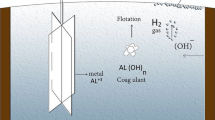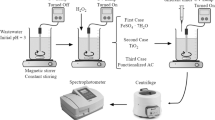Abstract
Textile production is one of the largest sectors in the manufacturing industry; however, the textile dyeing process produces a voluminous amount of highly colored wastewater. The dyes used are organic compounds of different dye classes that are stable in an aquatic environment with low decomposition rates. This study investigated the removal efficiency of five textile dyes of different dye classes (Disperse Orange 30, Acid Blue 324, Basic Yellow 28, Reactive Black 5, Vat Brown 1) from wastewater by electrocoagulation (EC) process that was equipped with aluminum electrodes. EC process achieved 91.98, 98.13, 47.46, 92.55, and 82.60% removal efficiencies for AB324, BY28, VBI, and RB5, respectively, at a current density of 0.83 mA/cm2. The energy consumption for dyestuff removal was in the following order: DO30 < VB1 < RB5 < AB324 < BY28. The total operating cost per kilogram of dyestuff removed in 15 min at 0.0502 mA/cm2 was determined as 0.250, 0.274, 0.550, 0.647, and 0.764 $/kg for DO30, VB1, RB5, AB324, and BY28, respectively. The removal mechanism was well fitted to the pseudo-first-order kinetic model with R2 above 0.94 for AB324, BY28, and RB5 dyes. However, the removals for DO30 and VBI dyes were exponential and neither fitted the first-order kinetic nor second-order kinetic model. The overall removal trend was as follows: DO30 > VB1 > AB324 > RB5 > BY28. Therefore, the use of dyes that can easily be removed from wastewater should be encouraged to preserve the quality of water in the receiving environments and to reduce the cost of wastewater treatment.





Similar content being viewed by others
References
Albahnasawi A, Yüksel E, Gürbulak E, Duyum F (2020) Fate of aromatic amines through decolorization of real textile wastewater under anoxic-aerobic membrane bioreactor. J Environ Chem Eng 8(5):104226
Aoudj S, Khelifa A, Drouiche N, Hecini M, Hamitouche H (2010) Electrocoagulation process applied to wastewater containing dyes from textile industry. Chem Eng Process 49(11):1176–1182
Ardhan N, Ruttithiwapanich T, Songkasiri W, Phalakornkule C (2015) Comparison of performance of continuous-flow and batch electrocoagulators: a case study for eliminating reactive blue 21 using iron electrodes. Sep Purif Technol 146:75–84
Bener S, Bulca Ö, Palas B, Tekin G, Atalay S, Ersöz G (2019) Electrocoagulation process for the treatment of real textile wastewater: effect of operative conditions on the organic carbon removal and kinetic study. Process Saf Environ Prot 129:47–54
Bhatia D, Sharma NR, Singh J, Kanwar RS (2017) Biological methods for textile dye removal from wastewater: a review. Crit Rev Environ Sci Technol 47(19):1836–1876
Cañizares P, Martínez F, Jiménez C, Lobato J, Rodrigo MA (2007) Coagulation and electrocoagulation of wastes polluted with colloids. Sep Sci Technol 42(10):2157–2175
Chafi M, Gourich B, Essadki A, Vial C, Fabregat A (2011) Comparison of electrocoagulation using iron and aluminium electrodes with chemical coagulation for the removal of a highly soluble acid dye. Desalination 281:285–292
Chanikya P, Nidheesh P, Babu DS, Gopinath A, Kumar MS (2021) Treatment of dyeing wastewater by combined sulfate radical based electrochemical advanced oxidation and electrocoagulation processes. Sep Purif Technol 254:117570
Chicatto J, Rainert K, Gonçalves M, Helm C, Altmajer-Vaz D, Tavares L (2018) Decolorization of textile industry wastewater in solid state fermentation with Peach-Palm (Bactris gasipaes) residue. Braz J Biol 78:718–727
Criado SP, Gonçalves MJ, Tavares LBB, Bertoli SL (2020) Optimization of electrocoagulation process for disperse and reactive dyes using the response surface method with reuse application. J Clean Prod 275:122690
Dai R, Chen X, Xiang X, Wang Y, Wang F (2018) Understanding azo dye anaerobic bio-decolorization with artificial redox mediator supplement: considering the methane production. Biores Technol 249:799–808
Daneshvar N, Sorkhabi HA, Kasiri M (2004) Decolorization of dye solution containing Acid Red 14 by electrocoagulation with a comparative investigation of different electrode connections. J Hazard Mater 112(1–2):55–62
Federation WE, Association A (2005) Standard methods for the examination of water and wastewater. American Public Health Association (APHA), Washington
Gupta VK, Pathania D, Kothiyal N, Sharma G (2014) Polyaniline zirconium (IV) silicophosphate nanocomposite for remediation of methylene blue dye from waste water. J Mol Liq 190:139–145
Hamad H, Bassyouni D, El-Ashtoukhy E-S, Amin N, Abd El-Latif M (2018) Electrocatalytic degradation and minimization of specific energy consumption of synthetic azo dye from wastewater by anodic oxidation process with an emphasis on enhancing economic efficiency and reaction mechanism. Ecotoxicol Environ Saf 148:501–512
Khataee A, Vatanpour V, Ghadim AA (2009) Decolorization of CI Acid Blue 9 solution by UV/Nano-TiO2, Fenton, Fenton-like, electro-Fenton and electrocoagulation processes: a comparative study. J Hazard Mater 161(2–3):1225–1233
Kim T-H, Park C, Shin E-B, Kim S (2002) Decolorization of disperse and reactive dyes by continuous electrocoagulation process. Desalination 150(2):165–175
Kobya M, Demirbas E, Can O, Bayramoglu M (2006) Treatment of levafix orange textile dye solution by electrocoagulation. J Hazard Mater 132(2–3):183–188
Kobya M, Omwene PI, Sarabi SM, Yildirim S, Ukundimana Z (2021) Phosphorous removal from anaerobically digested municipal sludge centrate by an electrocoagulation reactor using metal (Al, Fe and Al-Fe) scrap anodes. Process Saf Environ Prot 152:188–200
Maas R, Chaudhari S (2005) Adsorption and biological decolourization of azo dye Reactive Red 2 in semicontinuous anaerobic reactors. Process Biochem 40(2):699–705
Mansouri K, Ibrik K, Bensalah N, Abdel-Wahab A (2011) Anodic dissolution of pure aluminum during electrocoagulation process: influence of supporting electrolyte, initial pH, and current density. Ind Eng Chem Res 50(23):13362–13372
Martínez-Huitle CA, Rodrigo MA, Sires I, Scialdone O (2015) Single and coupled electrochemical processes and reactors for the abatement of organic water pollutants: a critical review. Chem Rev 115(24):13362–13407
Mollah MYA, Schennach R, Parga JR, Cocke DL (2001) Electrocoagulation (EC)—science and applications. J Hazard Mater 84(1):29–41
Nandi BK, Patel S (2017) Effects of operational parameters on the removal of brilliant green dye from aqueous solutions by electrocoagulation. Arab J Chem 10:S2961–S2968
Omwene P, Kobya M (2018) Treatment of domestic wastewater phosphate by electrocoagulation using Fe and Al electrodes: a comparative study. Process Saf Environ Prot 116:34–51
Phalakornkule C, Polgumhang S, Tongdaung W, Karakat B, Nuyut T (2010) Electrocoagulation of blue reactive, red disperse and mixed dyes, and application in treating textile effluent. J Environ Manage 91(4):918–926
Şengil İA, Özacar M (2009) The decolorization of CI Reactive Black 5 in aqueous solution by electrocoagulation using sacrificial iron electrodes. J Hazard Mater 161(2–3):1369–1376
Suresh P, Vijaya JJ, Kennedy LJ (2014) Photocatalytic degradation of textile-dyeing wastewater by using a microwave combustion-synthesized zirconium oxide supported activated carbon. Mater Sci Semicond Process 27:482–493
Xiong Y, Strunk PJ, Xia H, Zhu X, Karlsson HT (2001) Treatment of dye wastewater containing acid orange II using a cell with three-phase three-dimensional electrode. Water Res 35(17):4226–4230
Xu L, Cao G, Xu X, Liu S, Duan Z, He C, Wang Y, Huang Q (2017) Simultaneous removal of cadmium, zinc and manganese using electrocoagulation: influence of operating parameters and electrolyte nature. J Environ Manage 204:394–403
Yildiz YŞ (2008) Optimization of Bomaplex Red CR-L dye removal from aqueous solution by electrocoagulation using aluminum electrodes. J Hazard Mater 153(1–2):194–200
Zhu Y, Cao X, Cheng Y, Zhu T (2018) Performances and structures of functional microbial communities in the mono azo dye decolorization and mineralization stages. Chemosphere 210:1051–1060
Acknowledgments
The authors wish to thank all who assisted in conducting this work.
Author information
Authors and Affiliations
Contributions
Philip Isaac Omwene was involved in writing—original draft, investigation. Orhan Taner Can helped in conceptualization, resources, supervision, writing—review & editing. Ufuk Muhammed Oz was involved in investigation, formal analysis, data curation. Ramazan Keyikoglu contributed to investigation, project administration.
Corresponding author
Ethics declarations
Conflict of interest
The authors declare that they have no conflict of interest.
Additional information
Editorial responsibility: Parveen Fatemeh Rupani.
Supplementary Information
Below is the link to the electronic supplementary material.
Rights and permissions
Springer Nature or its licensor (e.g. a society or other partner) holds exclusive rights to this article under a publishing agreement with the author(s) or other rightsholder(s); author self-archiving of the accepted manuscript version of this article is solely governed by the terms of such publishing agreement and applicable law.
About this article
Cite this article
Omwene, P.I., Can, O.T., Öz, U.M. et al. Investigating the removal efficiency of different textile dye classes from wastewater by electrocoagulation using aluminum electrodes. Int. J. Environ. Sci. Technol. 20, 13009–13020 (2023). https://doi.org/10.1007/s13762-023-04841-9
Received:
Revised:
Accepted:
Published:
Issue Date:
DOI: https://doi.org/10.1007/s13762-023-04841-9




